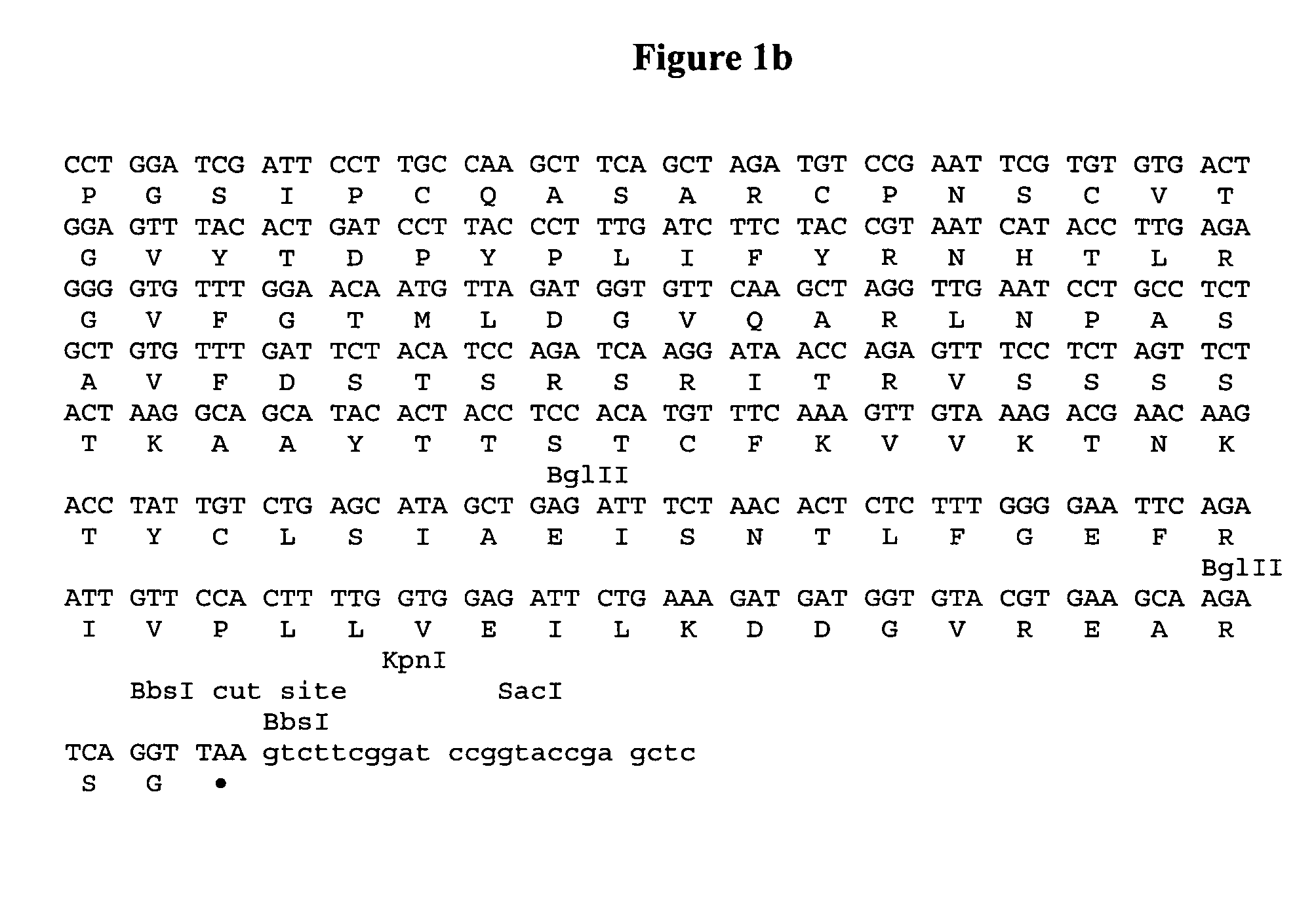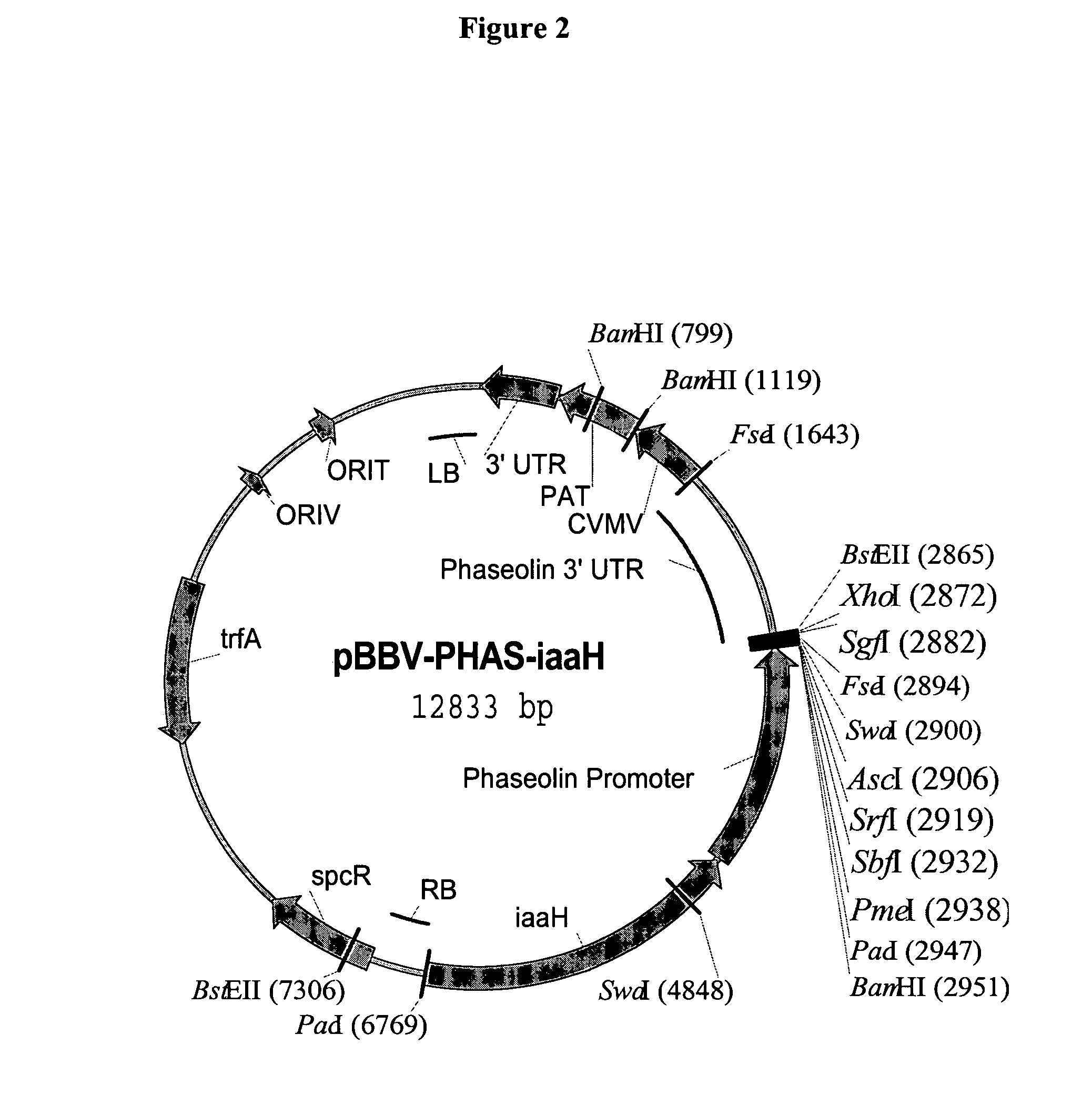Vectors and cells for preparing immunoprotective compositions derived from transgenic plants
a technology of transgenic plants and cells, applied in the field of plant molecular biology, can solve the problems of difficult production and purification of subunit vaccines
- Summary
- Abstract
- Description
- Claims
- Application Information
AI Technical Summary
Benefits of technology
Problems solved by technology
Method used
Image
Examples
example 1
Vectors
[0207]Gene Construction: The coding sequence of the HN gene of NDV strain “Lasota” (GenBank accession AF077761) was analyzed for codon use and the presence of undesired sequence motifs that could mediate spurious MRNA processing and instability, or methylation of genomic DNA. See Adang M J, Brody M S, Cardineau G, Eagan N, Roush R T, Shewmaker C K, Jones A, Oakes J V, McBride K E (1993) The construction and expression of Bacillus thuringiensis cryIIIA gene in protoplasts and potato plants. Plant Mol Biol 21:1131-1145. A plant-optimized coding sequence was designed with hybrid codon preference reflecting tomato and potato codon usage (Ausubel F., et al., eds. (1994)Current Protocols in Molecular Biology, vol. 3, p. A.1C.3 Haq T A, Mason H S, Clements J D, Amtzen C J (1995) Oral immunization with a recombinant bacterial antigen produced in transgenic plants. Science 268:714-716). The designed sequence is shown in FIG. 1. The synthetic HN gene was assembled by a commercial suppl...
example 2
Preparation of Transgenic Nicotiana tabacum
[0217]Three to 4 days prior to transformation, a 1 week old NT-1 culture was sub-cultured to fresh medium by adding 2 ml of the NT-1 culture into 40 ml NT-1 media. The sub-culture was maintained in the dark at 25±1° C. on a shaker at 100 rpm.
[0218]
NT-1 MediumReagentPer literMS salts4.3gMES stock (20X)50mlB1 inositol stock (100X)10mlMiller's I stock3ml2,4-D (1 mg / ml)2.21mlSucrose30gpH to 5.7 ± 0.03[0219]B1 Inositol Stock (100×)(1 liter)[0220]Thiamine HCl (Vit B1)—0.1 g[0221]MES (20×) (1 liter)[0222]MES (2-N-morpholinoethanesulfonic acid)—10 g[0223]Myoinositol—10 g[0224]Miller's I (1 liter)[0225]KH2PO4—60 g
[0226]Agrobacterium tumefaciens containing the expression vector of interest was streaked from a glycerol stock onto a plate of LB medium containing 50 mg / l spectinomycin. The bacterial culture was incubated in the dark at 30° C. for 24 to 48 hours. One well-formed colony was selected, and transferred to 3 ml of YM medium containing 50 mg / ...
example 3
[0237]Cell Culture: NT-1 tobacco suspension cultures (non-transgenic and transgenic lines) were maintained in 250 ml Erlenmeyer flasks. Initially, the cells were cultured in a modified liquid Linsmaier and Skoog medium (LS) (1965). The medium, designated LSg, contained LS salts and vitamins, 30 g 1−1 glucose, and 0.05 mg 1−1 2,4-dichlorophenoxyacetic acid (2,4-D). The pH of the medium was adjusted to 5.8. The cultures were transferred to fresh medium weekly by transferring 6 ml of 7-day-old cultures into 50 ml of LSg medium.
[0238]Based on poor growth of the cells in LSg medium, two additional media were investigated which were designated KCMS and NT-1. KCMS contained Murashige and Skoog (MS) (1962) salts, 1.3 mg 1−1 thiamine, 200 mg 1−1 KH2PO4, 30 g 1−1 and 0.1 mg 1−1 kinetin. NT-1 medium contained MS salts, 180 mg 1−1 KH2PO4, 0.5 mg 1−1 2-N-morpholinoethanesulfonic acid, 1 mg 1−1 thiamine, 100 mg 1−1 myoinositol, 30 g 1−1 sucrose, and 2.21 mg 1−1 2,4-D. The pH of bo...
PUM
| Property | Measurement | Unit |
|---|---|---|
| size | aaaaa | aaaaa |
| volume | aaaaa | aaaaa |
| volume | aaaaa | aaaaa |
Abstract
Description
Claims
Application Information
 Login to View More
Login to View More - R&D
- Intellectual Property
- Life Sciences
- Materials
- Tech Scout
- Unparalleled Data Quality
- Higher Quality Content
- 60% Fewer Hallucinations
Browse by: Latest US Patents, China's latest patents, Technical Efficacy Thesaurus, Application Domain, Technology Topic, Popular Technical Reports.
© 2025 PatSnap. All rights reserved.Legal|Privacy policy|Modern Slavery Act Transparency Statement|Sitemap|About US| Contact US: help@patsnap.com



